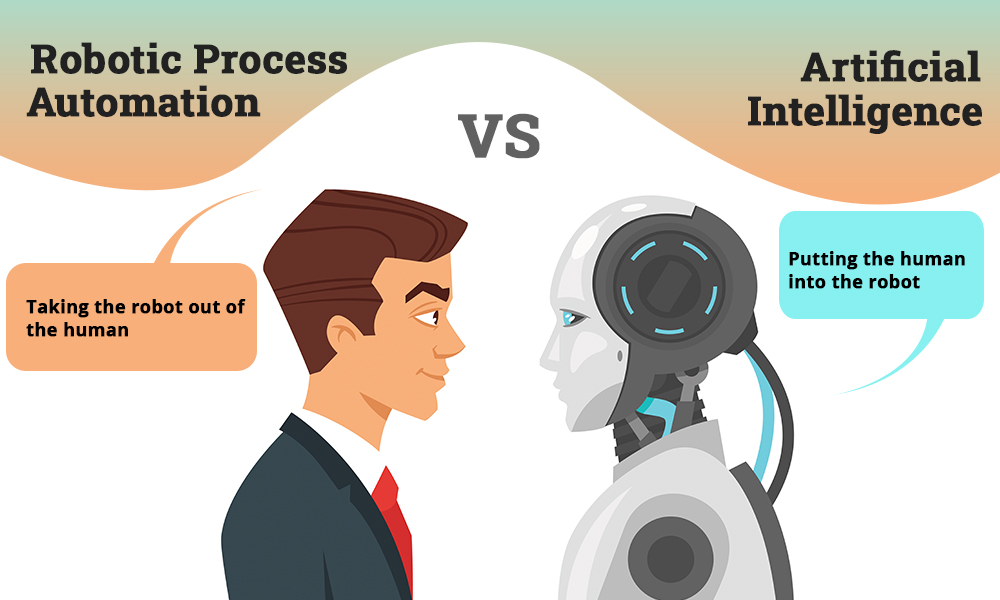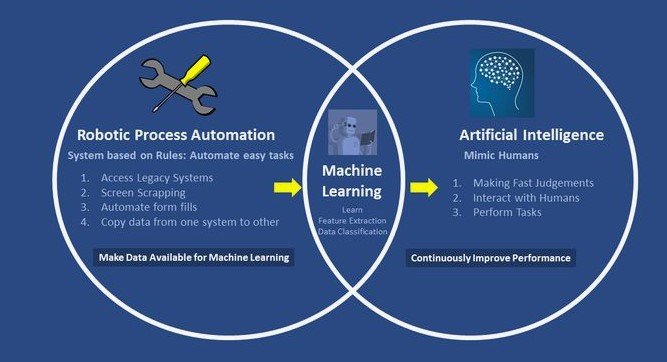Machine Learning (ML) involves algorithms that learn from data to make predictions or decisions. Robotic Process Automation (RPA) automates repetitive tasks using software robots without learning capabilities.
Machine learning and robotic process automation are transformative technologies reshaping industries. ML enables systems to analyze vast amounts of data, uncover patterns, and improve decision-making. RPA focuses on automating routine, rule-based tasks, freeing up human workers for more complex roles.
Together, they enhance efficiency and accuracy in business processes. Companies leverage ML for insights and predictive analytics while utilizing RPA to streamline operations. Understanding the differences and synergies between these technologies is crucial for organizations aiming to innovate and stay competitive. Their combined power can lead to significant cost savings and improved productivity across various sectors.
Machine Learning And Robotic Process Automation

Table of Contents
Introduction To Ml And Rpa
Machine Learning (ML) and Robotic Process Automation (RPA) are transforming industries. These technologies make tasks easier and faster. They help businesses save time and money. Understanding ML and RPA is essential in today’s tech-driven world.
What Is Machine Learning?
Machine Learning is a branch of artificial intelligence. It enables computers to learn from data. Instead of following static instructions, machines adapt based on experiences. This leads to better decision-making.
Key features of Machine Learning include:
- Data-Driven: ML uses large sets of data.
- Adaptive: Systems improve over time.
- Predictive: ML can forecast outcomes.
Machine Learning uses various techniques:
- Supervised Learning: Trains on labeled data.
- Unsupervised Learning: Finds patterns in unlabeled data.
- Reinforcement Learning: Learns through trial and error.
Here’s a simple table summarizing ML techniques:
| Technique | Description |
|---|---|
| Supervised Learning | Uses labeled data for training. |
| Unsupervised Learning | Identifies patterns without labels. |
| Reinforcement Learning | Rewards good actions to learn. |
In simple terms, Machine Learning helps machines get smarter by learning from data.
What Is Robotic Process Automation?
Robotic Process Automation (RPA) is a technology that automates repetitive tasks. RPA uses software robots to handle routine processes. It works best for tasks that follow clear rules and steps.
Key benefits of RPA include:
- Efficiency: Speeds up processes significantly.
- Accuracy: Reduces human errors.
- Cost-Effective: Saves money on manual tasks.
RPA can be applied in various areas:
- Data Entry: Automates inputting data.
- Invoice Processing: Handles billing tasks.
- Customer Service: Manages simple queries.
Here’s a table showing RPA applications:
| Application | Description |
|---|---|
| Data Entry | Automates data input tasks. |
| Invoice Processing | Streamlines billing procedures. |
| Customer Service | Answers common customer questions. |
In essence, RPA helps businesses run smoothly by automating tasks and freeing up human workers for more complex jobs.

Key Differences
Machine Learning and Robotic Process Automation are powerful technologies. They help businesses work smarter. Understanding their key differences is essential. This knowledge can help companies choose the right tool for their needs.
Functionality Comparison
Machine Learning (ML) and Robotic Process Automation (RPA) serve different functions. Here’s a clear comparison:
| Feature | Machine Learning | Robotic Process Automation |
|---|---|---|
| Purpose | Analyzes data to make predictions. | Automates repetitive tasks. |
| Learning | Improves over time with new data. | Follows pre-set rules and scripts. |
| Complexity | Handles complex problems. | Handles simple, rule-based tasks. |
| Data Usage | Requires large amounts of data. | Works with structured data only. |
Machine Learning focuses on understanding patterns. It uses algorithms to analyze data. This enables machines to learn and make decisions. RPA focuses on automating routine processes. It saves time by reducing manual tasks. RPA cannot learn from data like ML can. It merely follows the instructions given.
In summary, ML is about learning and improving. RPA is about efficiency and automation. Understanding these differences helps businesses choose wisely.
Use Cases
Both Machine Learning and Robotic Process Automation have unique use cases. Here are some examples for each:
- Machine Learning:
- Predictive maintenance in manufacturing.
- Customer behavior analysis in retail.
- Fraud detection in finance.
- Personalized recommendations in streaming services.
- Robotic Process Automation:
- Invoice processing in accounting.
- Data entry in HR systems.
- Customer support ticket management.
- Report generation in various departments.
Machine Learning shines in tasks that need analysis and insights. It helps in making predictions. RPA excels in tasks that are repetitive and rule-based. It frees employees to focus on more important work. Understanding these use cases helps companies implement the right technology.
Integration Benefits
Machine Learning (ML) and Robotic Process Automation (RPA) are powerful tools. Their integration brings many benefits. Businesses can enjoy increased efficiency and lower costs. By combining these technologies, organizations can automate routine tasks and make smarter decisions.
Enhanced Efficiency
Integrating Machine Learning with Robotic Process Automation boosts efficiency in many ways. First, ML analyzes data faster than humans. RPA handles repetitive tasks smoothly. Together, they create a seamless workflow. Here are some key benefits:
- Speed: Tasks that took hours can now be done in minutes.
- Accuracy: Automation reduces human errors.
- Scalability: Businesses can grow without adding extra staff.
The table below shows how integration improves workflow:
| Task | Before Integration | After Integration |
|---|---|---|
| Data Entry | 1 hour | 5 minutes |
| Error Rate | 5% | 0.5% |
| Scalability | Limited | Unlimited |
This clear improvement shows how businesses can benefit. Tasks become faster and more reliable.
Cost Reduction
Integrating ML and RPA also leads to significant cost savings. By automating tasks, companies can reduce labor costs. They can reallocate employees to higher-value work. Here are some ways costs decrease:
- Reduced Labor Costs: Fewer employees are needed for repetitive tasks.
- Lower Operational Costs: Automation streamlines processes, saving time and resources.
- Minimized Errors: Fewer mistakes lead to less money spent on fixing problems.
The following table highlights potential savings:
| Expense Type | Before Integration | After Integration |
|---|---|---|
| Labor Costs | $100,000 | $60,000 |
| Operational Costs | $50,000 | $30,000 |
| Error Fixing Costs | $20,000 | $5,000 |
These savings allow companies to invest in growth. The integration of ML and RPA is a smart financial move.
Industry Applications
Machine Learning (ML) and Robotic Process Automation (RPA) are changing industries. They improve efficiency, reduce costs, and enhance decision-making. Many sectors benefit from these technologies. Let’s explore their industry applications, focusing on finance and healthcare.
Finance Sector
The finance sector utilizes ML and RPA to streamline operations. These tools help in various tasks, making processes faster and more accurate. Here are some key applications:
- Fraud Detection: ML algorithms analyze transactions in real-time to spot unusual patterns.
- Risk Assessment: RPA helps in assessing customer profiles using historical data.
- Customer Service: Chatbots powered by ML provide instant assistance to clients.
- Regulatory Compliance: Automated processes ensure adherence to financial regulations.
These applications lead to better security and improved customer experiences. The following table summarizes the benefits:
| Application | Benefits |
|---|---|
| Fraud Detection | Quick identification of suspicious activities |
| Risk Assessment | Accurate evaluation of potential risks |
| Customer Service | 24/7 support without human intervention |
| Regulatory Compliance | Reduced risk of penalties and fines |
Overall, the finance sector achieves greater efficiency and security through these technologies.
Healthcare Sector
The healthcare sector also benefits greatly from ML and RPA. These technologies enhance patient care and streamline administrative tasks. Here are some prominent applications:
- Patient Diagnosis: ML algorithms analyze medical data to assist doctors in diagnosing diseases.
- Appointment Scheduling: RPA automates scheduling, reducing wait times for patients.
- Drug Discovery: ML speeds up the research process in finding new medications.
- Billing and Claims Processing: RPA ensures accurate billing and faster claims approval.
The benefits of these applications are significant, as shown in the table below:
| Application | Benefits |
|---|---|
| Patient Diagnosis | Faster and more accurate diagnoses |
| Appointment Scheduling | Efficient management of patient visits |
| Drug Discovery | Shorter time to market for new drugs |
| Billing and Claims Processing | Reduced errors and quicker payments |
The healthcare sector enjoys improved patient outcomes and operational efficiency through these advanced technologies.
Challenges Faced
Machine Learning (ML) and Robotic Process Automation (RPA) are powerful tools. They help businesses work faster and smarter. Yet, they face several challenges. Understanding these challenges can help companies use these technologies better.
Technical Limitations
Machine Learning and Robotic Process Automation have some important technical challenges. These issues can affect how well they work. Here are some common technical limitations:
- Integration Issues: Combining ML and RPA with existing systems is tough.
- Scalability: Growing the system to handle more tasks can be difficult.
- Algorithm Accuracy: Machine learning models can make mistakes.
- Real-Time Processing: Analyzing data quickly can be a challenge.
Here’s a simple table showing some technical limitations:
| Limitation | Description |
|---|---|
| Integration Issues | Hard to connect with current systems. |
| Scalability | Challenges in expanding for more tasks. |
| Algorithm Accuracy | Sometimes models provide incorrect results. |
| Real-Time Processing | Difficulty in analyzing data instantly. |
These limitations can slow down business processes. Companies must find ways to address these issues.
Data Privacy Concerns
Data privacy is a big concern in the age of Machine Learning and RPA. These technologies collect and analyze large amounts of data. This raises questions about how safe that data is. Here are some main concerns:
- Data Breaches: Hackers can steal sensitive information.
- Informed Consent: Users must know how their data is used.
- Compliance: Companies must follow data protection laws.
Here’s a quick look at some data privacy concerns:
| Concern | Description |
|---|---|
| Data Breaches | Risk of sensitive data being stolen. |
| Informed Consent | Users need to understand data usage. |
| Compliance | Need to follow laws like GDPR. |
Addressing these privacy concerns is crucial for user trust. Companies must ensure data is safe and used responsibly.
Future Trends
The future of Machine Learning and Robotic Process Automation (RPA) looks bright and full of potential. These technologies are changing how we work and live. They help businesses operate faster and more efficiently. As we move forward, exciting trends will shape the landscape. Understanding these trends is vital for anyone interested in technology.
Ai Advancements
AI is advancing rapidly and will bring many changes. New algorithms make machines smarter. This means they can learn from data better than before. Here are some key advancements:
- Deep Learning: It mimics the human brain to recognize patterns.
- Natural Language Processing (NLP): Machines understand human language more effectively.
- Computer Vision: Machines can see and interpret visual data.
These advancements lead to more applications in different fields:
| Field | Application |
|---|---|
| Healthcare | Diagnosis and treatment recommendations |
| Finance | Fraud detection and risk assessment |
| Manufacturing | Predictive maintenance of machines |
AI will also become more accessible. Tools will help people use AI without deep technical skills. This democratization will open doors for many.
Evolving Job Roles
As AI and RPA grow, job roles will change. New positions will emerge, and some jobs will evolve. Here are some trends in job roles:
- Data Analysts: They will focus more on interpreting AI data.
- Automation Specialists: They will design and manage automated systems.
- AI Trainers: They will teach machines to learn better.
Workers will need to adapt to these changes. Here are some important skills:
- Understanding of AI and RPA technologies.
- Strong analytical skills.
- Ability to work with data.
Companies will invest in training programs. They want to prepare their employees for these new roles. This shift will create a more skilled workforce ready for the future.
Case Studies
Machine Learning and Robotic Process Automation (RPA) are changing how businesses operate. Case studies highlight real-world applications. They show how companies use these technologies to improve efficiency and accuracy. Understanding these examples helps businesses see the potential benefits.
Successful Implementations
Many organizations have successfully implemented Machine Learning and RPA. Here are a few notable examples:
- Banking Sector: A major bank automated its transaction processing. This reduced errors by 30% and improved speed.
- Healthcare: A hospital used Machine Learning for patient diagnosis. It increased accuracy by 25% in identifying diseases.
- Retail: An online store utilized RPA for inventory management. This saved 20 hours a week in manual tasks.
Below is a table summarizing these successful implementations:
| Industry | Implementation | Results |
|---|---|---|
| Banking | Automated transaction processing | 30% fewer errors |
| Healthcare | Machine Learning for diagnosis | 25% more accurate |
| Retail | RPA for inventory management | 20 hours saved weekly |
These examples show how effective Machine Learning and RPA can be. Companies that adopt these technologies see real benefits.
Lessons Learned
Successful implementations teach valuable lessons. Here are key takeaways:
- Start Small: Begin with a pilot project. This helps in understanding the technology.
- Engage Employees: Involve staff in the process. Their feedback is crucial for success.
- Continuous Learning: Stay updated with trends. Technology changes quickly.
Data shows that 70% of projects fail due to lack of planning. Proper planning is essential. Here are common pitfalls:
- Ignoring user feedback
- Underestimating costs
- Neglecting training
Businesses should learn from others’ experiences. This helps avoid mistakes and maximize success.
Getting Started
Getting started with Machine Learning (ML) and Robotic Process Automation (RPA) can seem overwhelming. Both technologies offer powerful tools to automate tasks and analyze data. Understanding the basics will help you make informed decisions. This guide covers essential tools, platforms, and best practices.
Tools And Platforms
Choosing the right tools and platforms is crucial for success in ML and RPA. Here are some popular options:
- Machine Learning Tools:
- TensorFlow: An open-source library for dataflow and differentiable programming.
- Scikit-Learn: A simple and efficient tool for predictive data analysis.
- PyTorch: A flexible deep learning framework.
- Robotic Process Automation Platforms:
- UiPath: An easy-to-use platform for automating business processes.
- Blue Prism: A robust tool for enterprise-level automation.
- Automation Anywhere: Offers cloud-based RPA solutions.
Here’s a table that summarizes key features:
| Tool/Platform | Type | Key Feature |
|---|---|---|
| TensorFlow | Machine Learning | Dataflow programming |
| UiPath | RPA | User-friendly interface |
| Automation Anywhere | RPA | Cloud-based |
Best Practices
Following best practices ensures a smooth journey into ML and RPA. Here are some tips:
- Start Small: Focus on simple tasks before scaling up.
- Understand Your Data: Clean and prepare data for better results.
- Choose the Right Metrics: Use relevant metrics to measure success.
- Involve Stakeholders: Get feedback from users to improve processes.
Document your processes thoroughly. This helps in troubleshooting and training new team members. Regularly update your systems to keep up with advancements.
Remember to test your automation solutions. This ensures they work as intended. A good testing strategy can save time and money.

Conclusion
Machine learning and robotic process automation are transforming industries. They streamline operations, reduce errors, and enhance decision-making. By integrating these technologies, businesses can achieve greater efficiency and innovation. Embracing this change is essential for staying competitive. The future holds exciting possibilities for those willing to adapt and evolve with these advancements.

